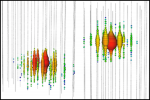For the first time, an international collaboration of scientists has detected extremely high-energy gamma rays, the most powerful type of light, coming from the outermost regions of an unusual star system within our own galaxy. The source is microquasar SS 433, a black hole that gobbles up stuff from a nearby companion star and blasts out powerful jets of material. The team’s observations, described in the October 4 issue of the journal Nature, represent the most energetic radiation ever detected from a microquasar in our galaxy.
A unique high-speed camera, designed to capture the fleeting effects of gamma rays crashing into the Earth’s atmosphere, will soon be on its way from the University of Wisconsin–Madison to Arizona’s Mount Hopkins.
IceCube data are stubbornly showing us only a glimpse of the extreme universe at a time. Ever since the discovery of a flux of TeV-PeV astrophysical neutrinos, scientists have been studying various potential sources of these neutrinos, and little by little, learning details about the composition of the cosmic neutrino flux.
If learning that you can turn your smart phone into a cosmic-ray telescope was astonishing, you will be now stunned to read how you can use cosmic particles to peek into your phone and measure one of its components.
Results from several new analyses with partial IceCube configurations are being published these days. The IceCube Collaboration is using several independent methods to build a step-by-step probe for the existence of an astrophysical neutrino flux in all detection channels. Each result published so far strengthens the evidence for an astrophysical neutrino flux that was recently presented by the IceCube Collaboration in Science.









